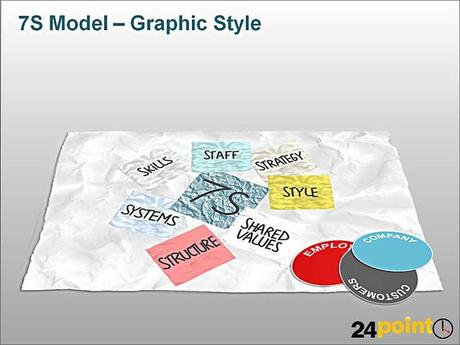McKinsey’s 7-S Framework has received considerable attention of management consultants and strategists. This framework was developed in the late 1970 by McKinsey, a well-known consultancy firm in the United States.
This framework is based on the proposal that effective organizational change is best understood in terms of the complex relationship between hard elements (strategy, structure, systems) and soft elements (style, skills, staff and shared values (or super-ordinate goals)); the seven S’s.
Hard elements can be easily identified and management can directly influence them. Some of them are: organization hierarchy, reporting lines, span of management, formal processes, IT systems and strategy statements.
Soft elements like style, skills, staff and shared values are as important as hard elements. They are more difficult to describe, less tangible and more influenced by culture.
The McKinsey 7-S model can a help an organization to:
- Determine how it is going to achieve its target goals
- Identify as to how it is going to align departments and processed during merger or acquisition
- Improve the style of the organization
- Examine the effects organizational changes within the company
- Implement policies to improve the skills and competencies of the employees
The framework upholds the viewpoint that there are multiple factors which influence on organization’s ability to change. Since the variables are interconnected, significant progress cannot be mode in other areas as well. The relevance of the model to strategic management is based on the 7-S which stand for policy areas vital to long-term organizational success.

McKinsey 7-S Model
• Shared Values (also called Superordinate Goals): The interconnecting center of McKinsey’s model is shared values. What does the organization stand for and what are its central beliefs, attitudes and core values?
• Strategy: This represents the plans for the allocation of a firm’s scarce resources, over time, to reach identified goals. How to cope with the future increase or decrease in demand for products and pressure from competitors?
• Structure: Structure means the way in which the organizational units relate to each other. Is the organizational hierarchy centralized or decentralized? What is the span of management and what are the lines of communication?
• Systems: Systems pertain to procedures, processes and routines that characterize how the work should be done: financial systems; recruiting, promotion and performance appraisal systems and information systems. What procedures, processes and routines does the organization use to keep on track?
• Staff: This means the numbers and types of personnel within the organization. Are there any open positions that needs to be filled? How many employees are sitting on bench?
• Style: Cultural style of the organization and how key managers behave in achieving the organizational goals. Do managers show effective leadership and are they able to motivate employees to work better?
• Skills: This represents the distinctive capabilities of the personnel or of the organization as a whole. How to monitor the skills sets of employees and what kind of training do they require to improve their performance?
Importance of McKinsey ‘s Framework
McKinsey’s framework is essentially a multivariate model of organizational change. It is recognized as a powerful expository tool as it highlights several organizational interconnections like those between staff and skills, strategy and systems which have critical significance for affecting organizational change. It underlines the criticality of action plans in the seven areas (S,) reflecting and organizational capacity of bringing about shifts in the strategy.
An effective implementation of strategy is thus shown to be conditioned by the ability of management to bring all 7-S into harmony.
The McKinsey also provides a convenient method of checking whether an organization has the necessary conditions for implementing strategy. This model also provides the basis on which the causes of shortfall may be diagnosed and remedial measures can be adopted. Furthermore, organizational capabilities may be evaluated along each of the seven dimensions.
Photo by: 24point0
References:

